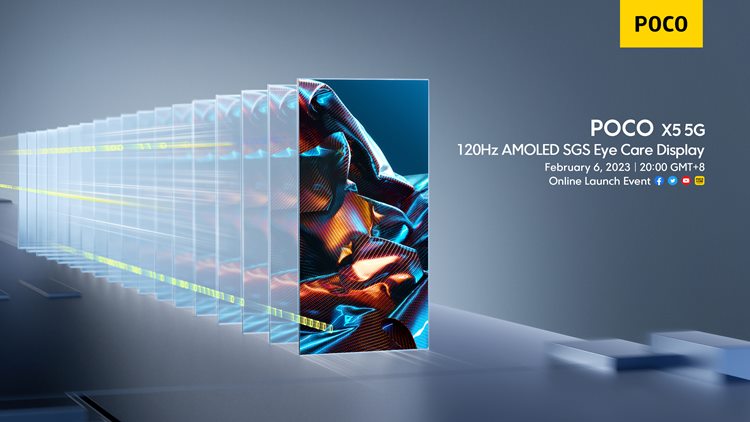Since the birth of smartphones, the evolution of mobile phone screens has never stopped. From resistive screen to capacitive screen, from straight screen to curved screen, from LCD to OLED… the square-inch screen in our hands is becoming more and more vivid. But for a long time, the latest and greatest screens seem to be exclusive to flagships. Is there any chance for mid-range phones to be equipped with better screens?
Sure! POCO, which has always been popular for being super cost-effective, has recently brought an all-around cost-effective quasi-flagship phone equipped with a top-level screen–POCO X5 Pro 5G. Like the previous phones, the configuration of POCO X5 Pro is also a surprise, and the main Flow AMOLED screen is extra eye-catching this time! What exactly is the Flow AMOLED screen? How is it different from our common OLED screen? What are the other highlights of POCO X5 Pro? Let’s look down together!

What is Flow AMOLED?
The technical principle of Flow AMOLED is similar to conventional OLED. It is composed of millions of organic light-emitting diodes, which will emit light when powered on. Of course, two sets of substrates are needed to clamp the light-emitting diodes to support and fix the screen.
The biggest difference between Flow AMOLED and conventional OLED screens is the material of the substrate. Unlike conventional OLED screens, Flow AMOLED screens use a special flexible substrate. Therefore, while retaining the advantages of traditional OLED screens, they have more characteristics than conventional OLED screens.
Due to its high plasticity and flexible screen, Flow AMOLED screens are widely used in high-end or flagship mobile phones. It can also use the most advanced COP packaging process in the industry to help reduce the width of the screen frame. Compared with conventional OLED screens, Flow AMOLED screens also have a certain shock absorption effect, are only half the thickness of traditional OLED screens, and are lighter in weight.
In general, just like its name, the Flow AMOLED screen has higher plasticity, lighter, thinner, and more drop-resistant. It is a more flexible and thinner AMOLED screen.
Flow AMOLED brings a thinner and lighter feel
Due to a series of excellent features, the Flow AMOLED screen has become the first choice for flagship phones. However, this time POCO is uncharacteristic and uses FLOW AMOLED to quasi-flagship models such as POCO X5 Pro, making it a phone with ultra-high cost performance.

Not only light and thin, but also bright colors and eye protection!
Although OLED screens have become the first choice for flagship mobile phone screens due to their advantages in display effects, many users with sensitive eyes like me may still prefer LCD screens. There is no other reason, OLED screens generally have low-frequency PWM dimming problems. This kind of low-frequency screen flicker problem will inevitably affect eye health. So this time, the screen of POCO X5 Pro is equipped with 1920Hz high-frequency PMW dimming technology to improve the eye protection function of the screen.
As currently recognized as one of the best screen dimming technology, 1920Hz PWM high-frequency dimming not only solves the problem of low-frequency flickering on OLED screens and hurts the eyes, but also has no image quality loss compared with the current mainstream DC-like dimming. From the actual experience, for people with very sensitive eyes like me, the night use experience of POCO X5 Pro is very good! There is no screen flicker problem under low brightness, the eyes are very comfortable, and the display effect of the screen is not affected in any way.
As far as the display effect is concerned, this high-quality 120Hz screen with 10 Bit display did not disappoint me. The high refresh rate of 120Hz brings a smooth experience, especially in streaming software such as Twitter and Facebook, the high refresh rate of 120Hz does have a silky smooth experience. In addition, this screen also supports a 10-bit display, which can display up to 1.07 billion colors. Compared with conventional 8-bit screens, the screen displays more accurate colors, and the transition between different colors is more natural. Whether it is for daily audio-visual entertainment or professional viewing of pictures, this screen is top-notch.
The rare thing is that Flow AMOLED, 1920Hz PWM dimming, 120Hz high refresh rate, and 10Bit color depth, these features that are only available on top flagship screens, have been used in quasi-flagship phones like POCO X5 Pro. It can verify the super high-cost performance of POCO X5 Pro.

Leapfrog flagship configuration and ultimate cost performance
Judging from the currently known configurations, whether it is Flow AMOLED screen, 1920Hz PWM dimming, these configurations that were originally exclusive to flagships are now available on POCO X5 Pro. As a cost-effective quasi-flagship phone, POCO X5 Pro is definitely a great value.
In terms of price, the current phones equipped with similar configurations are generally priced at more than 400 or even 500 US dollars. Considering POCO’s high-cost performance, the price of POCO X5 Pro may be within 400 US dollars. If so, POCO X5 Pro will become the first cost-effective bomb in 2023.
Based on this information, do you think POCO X5 Pro is cost-effective? Do you have any other expectations for the mobile phone screen? What do you think is the most appropriate price for POCO X5 Pro?
If you still want to know more about POCO X5 Pro, you can follow POCO’s official Twitter/Facebook/YouTube account. POCO will hold a new product launch conference on Feb. 6th, at 20:00 Beijing time. more surprises will be announced at the press conference. If you have other ideas about this product, welcome to comment and discuss!
Global:
FB
https://business.facebook.com/events/741221427523746/
